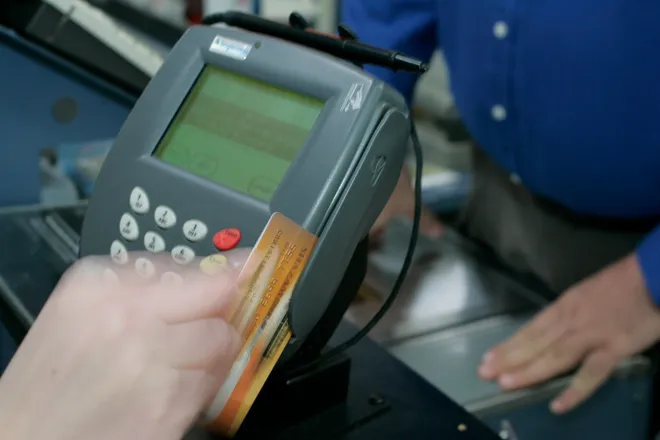A growing number of Americans are maxed out on their credit cards.
Nearly one-fifth of credit-card borrowers were using at least 90% of their available credit in the first quarter of 2024. The New York Fed called attention to America’s “maxed-out borrowers” in a report this week.
Credit card balances, and attendant delinquencies, have been rising steadily since late 2021, a sharp reversal from the historic lows recorded at the pandemic’s peak. Delinquencies have risen past pre-pandemic levels, the Fed reports.
Maxed-out cardholders are far more likely to miss payments. Borrowers who became delinquent in early 2024 had a median “utilization rate” of 90% on their cards: On average, they were pretty much maxed out.
“This makes sense,” the Fed report states, “since using practically all of your available credit could indicate a tight cash-flow situation.”
The nation’s collective credit-card balance stands at $1.12 trillion, near a record high, the Fed reports. The average card carries an interest rate of 21.6%, an all-time high. The average card balance was $6,360 at the end of 2023, according to TransUnion, another all-time high.
Credit-card delinquency is rising
Credit-card delinquency is rising. In the first quarter of 2024, 6.9% of credit card balances fell into “serious delinquency,” 90 or more days late, according to Fed data, up from 4.6% in early 2023.
The overall credit-card delinquency rate was 3.1% at the end of 2023, the highest level since 2011.
“There’s no question that people are leaning more on their cards to help them as prices continue to rise,” said Matt Schulz, chief credit analyst at LendingTree. “It also isn’t surprising that we’re seeing delinquencies increase.”
Younger Americans are more likely to be maxed out. According to the new Fed report, the share of maxed-out cardholders varies by generation: 4.8% for boomers, 9.6% for Gen X, 12.1% for millennials and 15.3% for Gen Z.
Those figures do not include delinquent cardholders. Add them in, and the numbers get bigger. Among all borrowers, current and delinquent, 18% of cardholders are maxed out.
Higher “max-out” rates for younger cardholders are partly a matter of credit limits: Younger borrowers have lower ones. The median credit limit for Gen Z is $4,500, the Fed says, compared with $16,300 for millennials.
“Lower limits make it easier to max out,” Schulz said.
Credit-card interest rates: ‘from bad to worse’
For borrowers who can’t keep up, there has probably never been a worse time to own a credit card. The average interest rate has risen by seven full points since early 2022, from 14.6% to 21.6%, according to federal data.
“It’s kind of gone from bad to worse,” said Ted Rossman, senior industry analyst at Bankrate, the personal finance site.
If you have a card balance of $5,000, at an interest rate of 21.6%, and you pay $100 a month, you will spend more than 10 years paying it off, according to a Bankrate calculator. And you will spend $7,906 in interest, on top of the $5,000 in principal.
“You can easily become trapped in a very dangerous debt cycle,” Rossman said.
Inflation feeds the cycle. Prices have risen steadily in the past few years. Inflation peaked at a 40-year high of 9.1% in mid-2022. Inflation eased to 3.4% in April but remains a drag on the American consumer.
Nearly half of all credit card holders carry balances from month to month, Bankrate has found in recent surveys.
In other words, at least half of all credit-card customers are not experiencing the credit-card crisis. The interest rate doesn’t matter if you pay the balance off at month’s end.
“For those who pay in full, life is great. They get rewards, they get buyer’s protections, they get convenience,” Rossman said.
“Do you have credit-card debt or not? That’s the big fork in the road.”
Credit-card crisis isn’t likely to ease soon
The credit-card crunch isn’t likely to ease any time soon, experts say. Inflation endures, and credit-card rates probably won’t ease while interest rates remain elevated overall.
Interest rates sit at a 23-year high, following a dramatic campaign of rate hikes to curb inflation. The Fed has balked at cutting rates until inflation is tamed.
“It’s going to get worse in months to come,” Schulz said.
What, then, is a maxed-out cardholder to do?
“First of all, if you’re in a hole, stop digging,” Rossman said. He recommends cardholders stop using a card that’s tapped out, so the monthly interest charges don’t get bigger.
“I know this might be easier said than done,” he said.
After that, “the thing that’s most important is to pay that balance down as soon as you possibly can,” Schulz said. “That’s job number one for anyone with a credit card.”
Pro tip: If you have the discipline to stop using your card, consider calling the issuer and asking for a higher credit limit, Schulz said. A higher limit means you’re using less of your available credit, a metric that can raise your credit score.
If you fear you lack the discipline to stop using your maxed-out card, maybe it’s time to get old-school.
“I would say, put the card away,” said Catherine Valega, a certified financial planner in Boston. “Hide it. Give it to a family member and say, ‘Don’t tell me where it is until my card is paid off.’”

